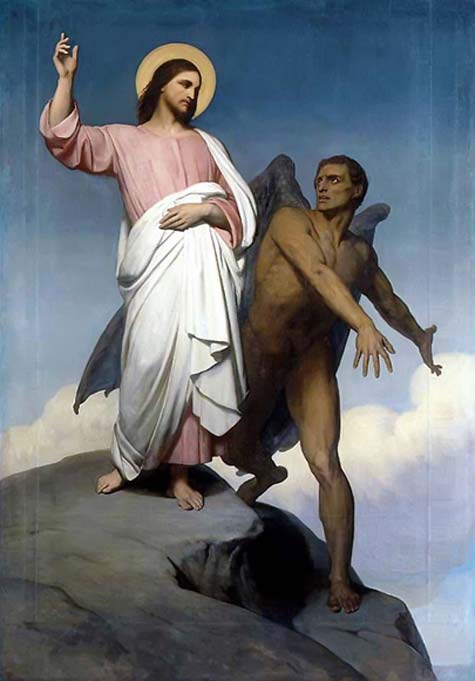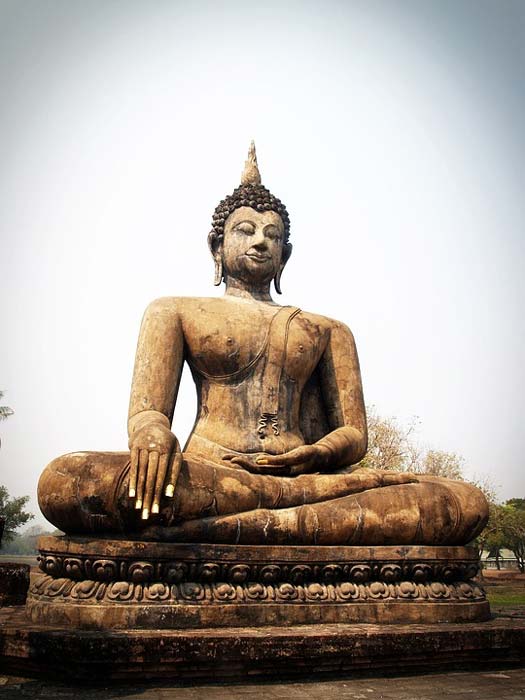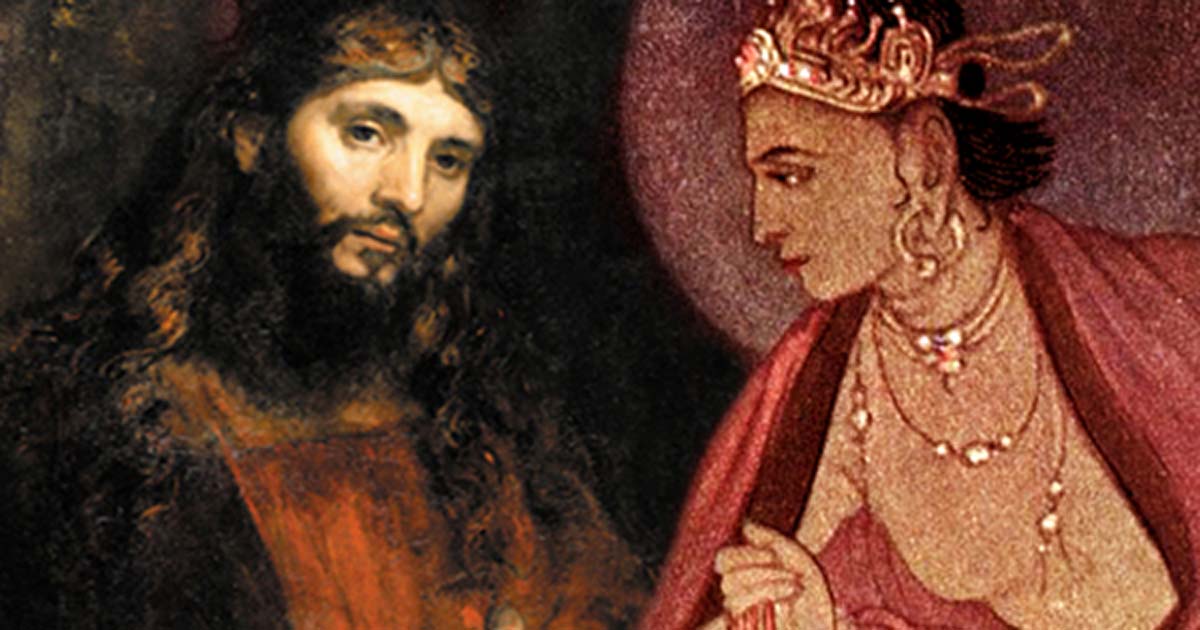The Christ And The Buddha: How Can You Explain the Uncanny Similarities?
Buddhism and Christianity arose independently of each other, separated as they were by almost 3,000 miles and at least 500 years. In terms of religious belief systems they are even farther apart. Many Buddhists, for instance, don't believe in a supreme being. Christianity is based on such a belief. The Buddha was careful to reject any efforts to label him a deity. Christ claimed to be one with God. The Buddha taught his followers to find the Middle Way between poles of opposites such as good and evil. Christ encouraged his disciples to choose the good and reject the evil.
But despite the differences there exists an uncanny similarity in how an underlying mythology shaped the stories of the founders of these two world religions. We can't help but wonder if writers shaped their origin story to fit a mythological pattern of some kind. The principle texts of both religions were written down only after decades, and in some cases centuries, had passed since the founder's death, leaving plenty of time to organize oral tradition into familiar and acceptable frameworks. How else can we explain such an uncanny similarity?
Both Left Home & Faced Down Evil
Consider the following:
Both Siddhartha Gautama, who was to become the Buddha, and Jesus of Nazareth, who was to become the Christ, are said to have left their homes in the prime of their lives, seeking truths that exist beyond the scope of most people's interest. Both were eventually led into a wilderness where, alone, they faced the devil and his traditional three temptations.

Scene of the Buddha's Great Departure from palatial life. Gandahara 1-2nd century. Guimet Museum. Personal photograph 2005. This scene depicts the "Great Departure" predestined being, he appears here surrounded by a halo, and accompanied by numerous guards, mithuna loving couples, and devata, come to pay homage. (CC BY-SA 3.0)
Siddhartha sat beneath the Bo tree where Mara, an old Hindu god and devil figure, confronted him.

Mara depicted in the Burmese style, attempting to tempt Buddha (CC BY-SA 3.0)
Jesus, in the wilderness, faced Satan, the fallen angel formerly known as Lucifer.

Lucifer depicted in The Temptation of Christ, by Ary Scheffer, 1854. (Public Domain)
It’s believed that both were tempted by the cravings of the flesh, the spirit, and worldly pride. Both emerged from that experience with a new teaching and immediately proclaimed their insights.
- The Cult of Mithra: Sacred Temples, and Vedic Legends, and Ancient Armenian Understanding
- 5,000-Year-Old Rock Painting Suggests a Nativity Scene 3,000 Years Before Jesus’ birth
- 3: The Perfect Number - Trinity Symbolism in World Religious Traditions
- The Truth Behind the Christ Myth: Ancient Origins of the Often Used Legend – Part I
Both Spread Teachings
The Buddha's first order of business was to deliver the famous Deer Park Discourse. Here he put forth the teaching that was to become the bedrock of Buddhism: The Four Noble Truths.

The Buddha teaching the Four Noble Truths. Sanskrit manuscript. Nālandā, Bihar, India. (Public Domain)
Jesus preached what has come to be known as the Sermon on the Mount, wherein he outlined, in the Beatitudes, a model for Christian life. Both sermons detailed, in systematic fashion, how followers were to live out the precepts of the founders.
Both Betrayed!
Both then selected a group of twelve disciples—one of whom was to later become a betrayer. Although the Buddha lived on into old life, both men eventually died at the hands of another man, who they each forgave before succumbing to death.

Kiss of Judas (1304–06), fresco by Giotto, Scrovegni Chapel, Padua, Italy (Public Domain)
Even the final words of the Buddha are echoed by the proclamations of Christianity.
The Buddha said, "Be ye lamps unto yourselves." Jesus said almost the same thing: "Ye are the light of the world."
The Buddha declared all matter in this world to be transitory. Jesus said: "Heaven and earth will pass away, but my words will not pass away."
The Buddha's last words are said to be, "Work out your own salvation with diligence." The Apostle Paul, speaking for Jesus, said, "Work out your own salvation with fear and trembling."
Both Founders Had Priesthoods and Symbolic Postures
The traditions that followed both men are equally interesting. Both developed a system of priesthood, complete with rules and regulations for men who ascended to positions of leadership.
- The Egyptian Goddess Isis, Found in India
- Those Who Once Reigned: Experts Name Famous and Forgotten Ancient Gods
- Devils or Angels? Defining the Dark Entities of Christianity’s Past
- The Laughing Buddha: The Eccentric Monk, God of Plenty and Patron of Bartenders
Buddhism soon split into two different factions. The oldest, Theravada, venerated the living Buddha with statues traditionally cast in one of three different positions. The well-known lotus, or seated position, represents the founder in his enlightenment, the position of meditation. The standing position represents Buddha the teacher. The reclining position pictures Buddha entering Nirvana.

Buddha statue in the well-known lotus position. (Public Domain)
This tradition parallels that of the traditional Catholic Church, which traces its ancestry back to the founder, Jesus. He, too, is often pictured in three traditional postures:
Sometimes he is praying, either alone in the desert or off in the mountains. Sometimes artistic renderings portray him teaching the multitudes. Other renditions show him ascending into heaven.
Both Theravada and the Catholic church thus place a great deal of artistic emphasis on their founder's private spiritual lives, public teaching and eventual journey into Nirvana or Heaven.
Both Belief Systems Broke Apart
But just as the Protestant Reformers broke away from the Catholic church, forming denominations that differed from one another in matters of tradition and theology, Mahayana Buddhism broke off from Theravada and formed new offshoots, among them Tantric Buddhism, Zen, Pure Land and Nichiren. Although these are not called "denominations," they formed in the same way many Protestant denominations did. Someone had a new insight, a new way of living out the tradition, and others followed.

Restoration of T'ang dynasty Nestorian image of Jesus as Christ found in Cave 17 at Mo-kao Caves, Tunhwang. The original work dated back to 9th century. (Public Domain)
More Alike Than Different
To this day, both Buddhism and Christianity have a multitude of followers, each living out the tenants of their founders with great zeal while often declaring their particular interpretation to be, if not the only way, then certainly the best and most authentic tradition. But given the similarities of the origin stories of the two world religions, one almost has to wonder if a hidden mythology is lurking unseen in the background — a central mythology that has shaped Buddhism and Christianity into the great forces they are today.
Jim Willis is author of nine books on religion and spirituality, he has been an ordained minister for over forty years while working part-time as a carpenter, the host of his own drive-time radio show, an arts council director and adjunct college professor in the fields of World Religions and Instrumental Music. He is author of The Religion Book: Places, Prophets, Saints, and Seers.
--
Top Image: Rembrandt - Christ with Hands Folded (Public Domain), and Nivedita, Sister - the Departure of Siddhartha (Public Domain);Deriv.
By Jim Willis
References
Ellwood, Robert S. and Barbara A. McGraw . Many Peoples, Many Faiths: Women and Men in the World Religions, 7th Edition . Upper Saddle River, NJ: Prentiss Hall, 2002.
Willis, Jim. The Religion Book: Places, Prophets, Saints and Seers. Detroit, MI: Visible Ink Press, 2004.


















Comments
There is no mystery about similarities between Buddhism and Christianity. By the time that Christ came along Buddhist ideas had been around for over 600 years, Christianity simply borrowed them!
They were both enlightened and had same experiances. Buddah went out and told his Father he was going to find the unknowable. He found the enlightenment at least twice as did Jesus. Jesus probably got his start in Egypt and achieved it at the river baptism by John the Baptist who had already achieved it. Moses probably reached that stage on the mount since reports that he glowed and that it appeared as horns from his head.
Both were able to do and perform things that were unexplainable as those with this connection today. As for religion lets look at that. Many died because of their enlightenment and would not follow the rules of the Gods of their day. Socrates wss killed because he would not acclaim the teachings and the edicts of the Gods of his day. Jesus would not do the same as dictated by the Romans to their Gods. The Romans killed him because he was teaching the way for many to achieve enlightenment. The deciples on Penticost received enlightenment and then went out.Paul was enlightened and there are 2 accounts. One said the travelers with him saw the light and no sound and another heard the sound but did not see Paul glow.
Ar far as religions are due. They are simply the relegio or regulations. These are made up by men to control the actions of people and provide money for them to live on. The Levite tribe were past masters at rules,go back and brush up on them. As far as enlightenment religions have no knowledge of any practice or meditation to achieve this advance in conciousness therefore religion and their rules are useless for enlightment. Lucifer was the light bearer who brought the light but was renounced because the church had lost their knowledge and santification of the light and had to cover it up.Most Buddhist do not call it religion because it is containe inside without some others rules.Present Christian Religions came about 300 or so AD because the Roman practices were worked into the Jesus words ,hense the loss of the method to achieve enlightment. The Roman church had Bruno killed because he would not agree that the sun etc revolved around the all important earth. He was burned alive at a stake to show the people what hell would be like if you disobeyed their religion. Socrates was killed because of the same thing. Those ruling in a religious world are to be obeyed at any cost even if their rules have nothing to do with ones advancement of conciousness, Before you critisize I will state I had probaly 10 seconds of a start to it and I can attest that that near connection changed my life.As for Gautama and his fathers wealth he never had it and lived outside.
Another attempt of grasping straws. First of all, the so-called Buddha was born a prince that was held in the palace until he chose to leave his infant child and wife so he could go out and "see" the suffering of others. His message was that "you are suffering because of desire" and chose not to share the wealth of being a prince to his neighbors, whereas Jesus not only lived among His neighbors, he encouraged the giving and sharing of wealth to alleviate suffering. Jesus didn't beg but the wealthy Prince Guatama did. What was Prince Guatama suffering from? It sure wasn't starvation or need of a home because he could go back any time he wanted. He walked out on his infant son the night it was born, so why do people think this man had any sense of ethical behavior? Jesus NEVER lived in Tibet, He was very well-known to the Pharisees and Jewish communities. Yes, He was born in Bethlehem and that census has been uncovered. Yes, His family lived in Egypt until Herod the Great died, then they went to Nazareth where His mother was from. They knew Him in Nazareth and made comments that Joseph was a carpenter. There is no evidence whatsoever that Joseph of Arimathea was His uncle or that He traveled to Britain to mine silver nor that He went to Tibet. Jesus was an Orthodox Jew that went to the Yeshiva of Shammai. He knew the Law of Moses and was constantly quoting Torah and Tanakh. His teaching was in opposition to Prince Guatama, suffering was not because of desire but that illness and other conditions were real and part of the human condition. Jesus taught that you have the ultimate human brotherhood responsibility to help alleviate the suffering of others. Prince Guatama taught that to alleviate your own suffering you had to do away with your own desires. Again, what was Prince Guatama deprived of that he had any need to desire anything? He knew that his wealth was preserved and he could avail himself of it any time. Exactly how did Prince Guatama do for people other than claiming twice to reach "enlightenment" when Jesus Christ gave His own life for others and was called "The Light of the world"? Compare the two honestly and when you realize that Prince Guatama was merely a 1%-er elitist who abandoned his infant and alienated his wife from normal marital affections, then perhaps you might become enlightened yourself. Did Guatama practice any "golden rule"? Nope, he said to beg for your food even if you have a house full of food, because that is what he did. At what point did Guatama ever give away his vast wealth to help the suffering of others? NEVER. His response was "You don't like your life? Well suffer, and you deserve to suffer because you have the desire to suffer". Seriously, do you people not even know what kind of person this Prince Guatama really was?
They were both reformers of the faiths into/under which they were born. The major difference between them was that Jesus was circumcised.
Jesus lived in Tibet as a Buddhist monk for many years as a teenager and then after his "death", when he resurrected there which explains the similarities between Buddhism and Christianity.
Pages